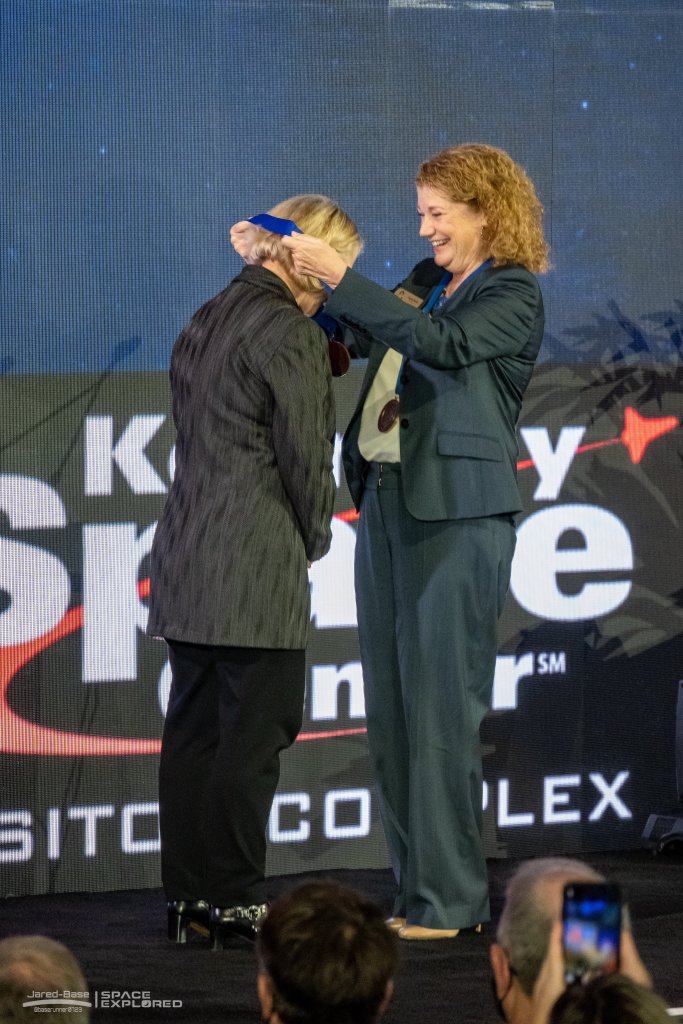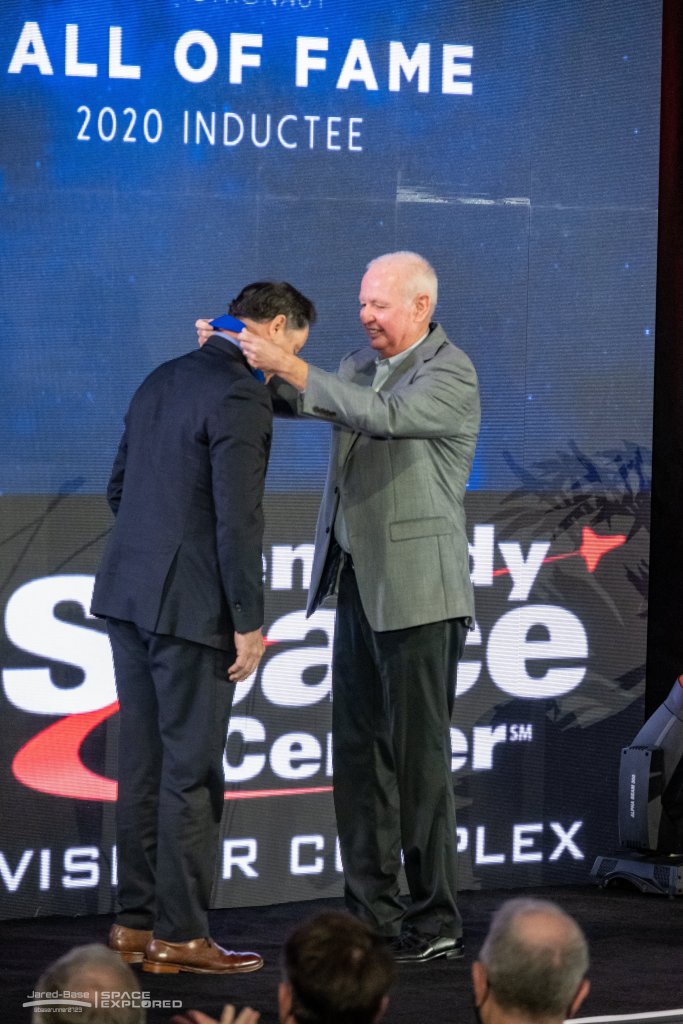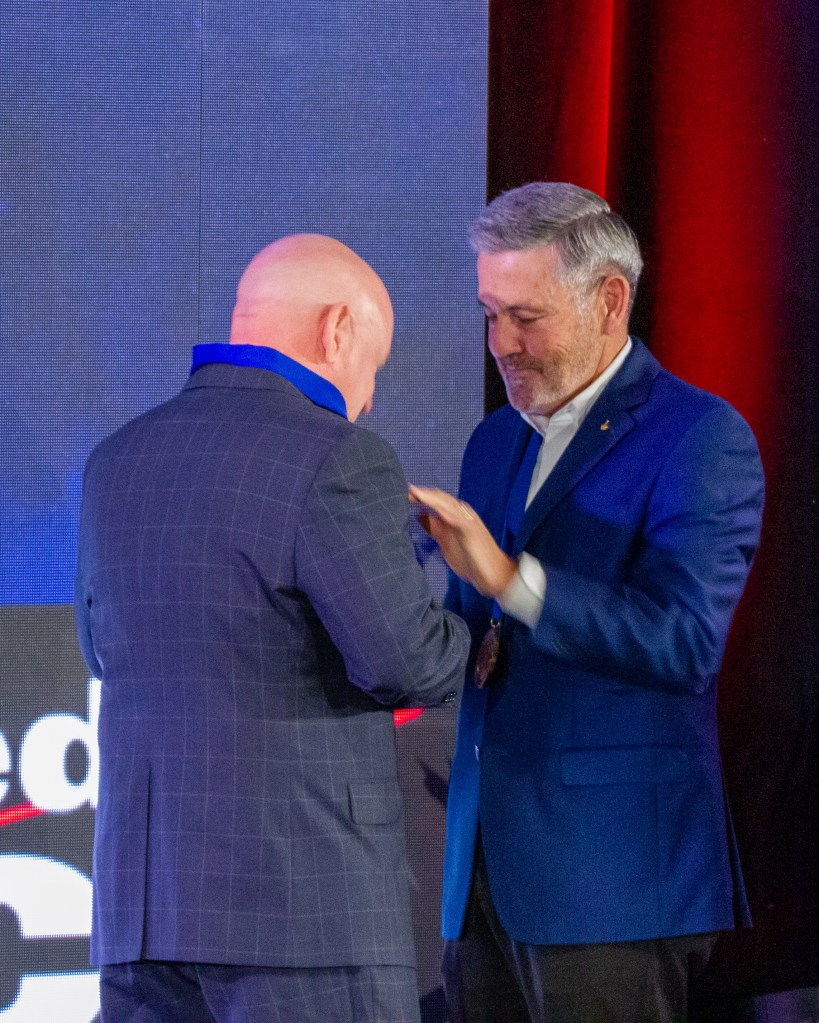
On Saturday, three NASA astronauts were inducted into the US Astronaut Hall of Fame. The induction ceremony took place at Kennedy Space Center Visitor Complex (KSCVC) and recognized former NASA astronauts Michael Lopez-Alegria, Pamela Melroy, and Scott Kelly.
Space Explored’s Jared Locke and Derek Wise were at the ceremony. The induction was hosted by former CNN space correspondent John Zarrella and featured many other notable speakers. Those speakers included COO of KSCVC Therrin Protze, Director of Communication and Public Engagement at KSC Hortense Blackwell, US Astronaut Hall of Fame members Curt Brown, Brian Duffy, Susan Helms, and Robert Cabana, and NASA Administrator Senator Bill Nelson.
There are some basic requirements before an astronaut can be considered for the Hall of Fame. An astronaut must have made their first flight at least 17 years prior to the induction and must have been retired from NASA for at least five years. Additionally, the astronaut must be a US citizen and a NASA-trained commander, pilot, or mission specialist who has orbited Earth at least once. From there, the selection process is run by the Astronaut Scholarship Foundation. The inductees are selected by a committee of Hall of Fame astronauts, former NASA officials, flight directors, historians, and journalists.
Below is a brief summary of each of their accomplishments; however, no summary can cover the true scope of their accomplishments. I also asked each of them if they would share the most awe-inspiring moment of their time as astronauts.

Michael Lopez-Alegria
Missions
- STS-73
- STS-92
- STS-113
- Soyuz TMA-9 (Expedition 14)
Planned missions
- SpaceX Axiom-1
Michael Lopez- Alegria, aka Michael L-A, was selected as a NASA astronaut in 1992. He served as a mission specialist on his three Space Shuttle flights, and as flight engineer on his Soyuz mission. He served as ISS commander, and will serve as commander on the private Axiom-1 mission to the ISS, set to launch on February 21, 2022.
He holds the record for most spacewalks, at 10, and the record for most cumulative time on spacewalks, at 67 hours and 40 minutes.
Most awe-inspiring moment as an astronaut?
“So, on this E.V.A. on the flight that Pam and I flew together, we did a test of this SAFER, this gas-powered jet pack for self-rescue, and we were waiting for some certain lighting conditions, so we were kind of chilling. My partner had his feet in a foot restraint on the end of the robot arm, and he was holding me, and we were coming up over the Yucatan peninsula – so it’s south-west to north-east. And I was looking down past him, past the space shuttle and the ISS, at the Caribbean, and that is just mind-blowing. The colors are so precious. That sticks in my mind as a real ‘aha!’ moment.”

Pamela Melroy
Missions
- STS-92
- STS-112
- STS-120
Pam Melroy was selected as an astronaut candidate in 1994. She served as pilot on her first two spaceflights and mission commander on her third.
She was sworn in as NASA Deputy Administrator on June 21, where she lays out the agency’s vision and represents the agency to the office of the President, Congress, and other government agencies.
Most awe-inspiring moment as an astronaut?
“So, on my first flight with Mike, we waved off a couple of landing attempts, and early in the day. So we were all up on the flight deck looking at the Earth from space, and it was wonderful.
And then everybody went downstairs except me, cause, you know, the sun was going down and you don’t see the Earth as much. And in fact, what you see during the day, is you see the magnificent Earth, like you described L-A.
But at night, all you see is the signs of people. You see lights spread out like diamonds on black velvet, and they tell you where people are. I thought about that for a while, and I realized how many times I waited to see the space shuttle go overhead, and I would always wave if I saw it go overhead. So I looked at the map and I said, ‘where are we over? Oh, we’re over China.’ It’s a place I’ve never been, I didn’t know anybody that lived there, but I thought, ‘I bet you somewhere down, there there’s a little girl, who’s waving up at me,’ so I waved back.
And, for me, the connection was, I couldn’t see her without lights – which is technology – and here I was floating around in sort-of the pinnacle of what humans can achieve in technology. People talk about technology as something that dehumanizes us, but at that moment, I felt it bringing us together.”

Scott Kelly
Missions
- STS-103
- STS-118
- Soyuz TMA-01M (Expedition 25/26)
- Soyuz TMA-16M/TMA-18M (Expedition 43-46)
Scott Kelly (and his twin brother Mark) was selected as an astronaut in 1996. On his first shuttle flight, he served as pilot on a Hubble servicing mission. He served as commander on his next shuttle mission.
He is perhaps most widely known for the “Year in Space” mission, when he spent 340 days on the International Space Station. The mission has helped NASA understand how the body reacts to long-duration space travel.
Most awe-inspiring moment as an astronaut?
“I would say, you know, the instant the solid rocket motors light on your first flight. You know, it gets your attention like nothing else, so much so that for the next… couple of years before my brother flew his first flight… I tried to explain to him what launch was going to be like. And then when he flew and landed, I was waiting right outside the hatch when he came out. The first thing he said to me, was that ‘I had no idea what that was going to feel like,’ after me trying to tell him for two years. That’s how incredible it is.”
Subscribe to Space Explored’s YouTube channel to stay tuned for our video from the event.

FTC: We use income earning auto affiliate links. More.








Comments